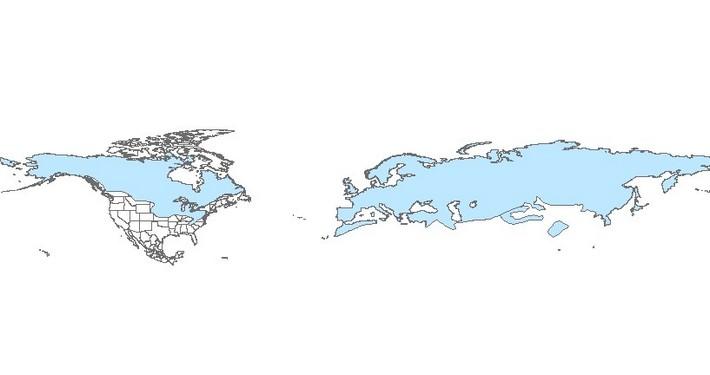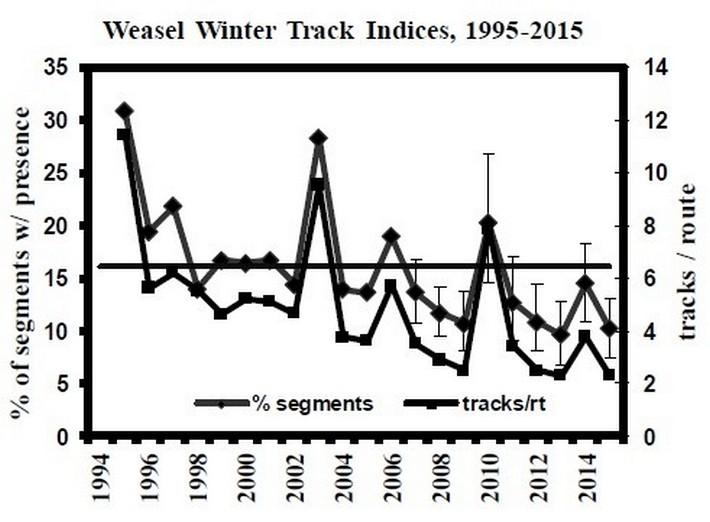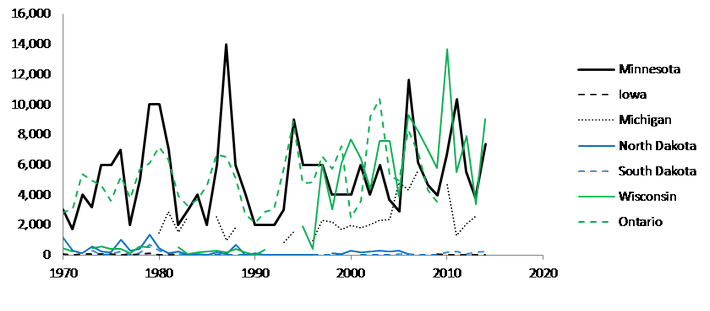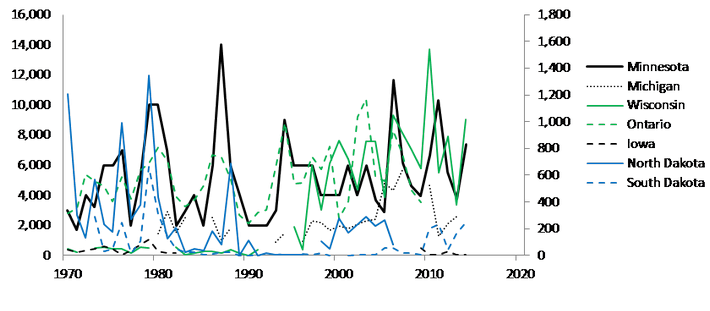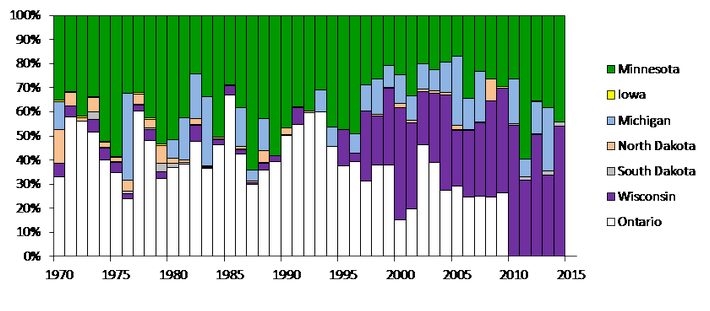
Description
Least weasels are small carnivores in the weasel family (Mustelidae). The major identification challenge is distinguishing least weasels from long-tailed weasels from ermine.
Long-tailed weasels are largest (total length 300-350 mm), ermine are medium sized (total length males 225-340 mm, females 190-290 mm), while least weasels are smallest (total length less than 250 mm in males and less than 225 mm in females; Svendsen, 1982). Long-tailed weasels have a tail longer than half their body length with a black tip, ermine have a tail length around a third of their body length with a black tip, and least weasels have a tail length around a quarter of their body length and lack a black tip. Only least weasel fur will fluoresce under ultraviolet light. Ermine and long-tailed weasels are more commonly detected in much of the Great lakes region, with least weasels less common.
Size
Measurements from Minnesota are from Hazard (1982), and from Wisconsin are from Jackson (1961).
Total length averaged 7.1” (180 mm) in Minnesota, ranged from 6.2” to 7.7” (157-195 mm) in Minnesota, and ranged from 6.8” to 8.1” (172-206 mm) in Wisconsin.Tail length averaged 1.3” (33 mm) in Minnesota, ranged from 1.1” to 1.5” (27-37 mm) in Minnesota, and ranged from 0.9” to 1.5” (24-38 mm) in Wisconsin.Total weight ranged from 1 to 2 oz (40-56 g) in Minnesota, and from 1 to 2 oz (41-50 g) in Wisconsin.
Males are typically larger than females.
Distribution & Status
Least weasels are found from Alaska and Canada through the upper Midwest, and portions of Appalachia. Regionally, populations range from secure in Michigan and South Dakota to vulnerable in Minnesota and Iowa, with incomplete information in Ontario, Wisconsin, and North Dakota.
Worldwide, Mustela nivalis has a circumpolar distribution, found throughout Europe, northern North Africa, and northern Asia. Other Mustela species occur throughout the world, except for Australia, Antarctica, and most oceanic islands.
Least weasels have an IUCN rank of Least Concern, IUCN information
Incidence in Minnesota
Weasels, including least weasels, are classified as unprotected species in Minnesota. Hunting and trapping are regulated by the Minnesota Department of Natural Resources, regulations.
From winter track data (1994-2015) it appears that Minnesota weasel populations are declining (Erb, 2015).
Population Trends
To help assess population trends, we can look at regional furbearer harvest data, methods.
Harvest data for ermines, long-tailed weasels, and least weasels are pooled as “weasels”, making it difficult to isolate individual species trends. Of the three pooled species, ermine are the most abundant over most of the Great Lakes region. There is a lot of year-to-year variation in harvest, making it difficult to detect any long-term trends.
Minnesota and Ontario dominate regional harvest, with Wisconsin harvest increasing significantly since the mid-1990s.
Life History
Least weasels primarily feed on mice and voles, but will also take insects, birds, and carrion. Least weasels do not have delayed implantation, and can have 2-3 litters in one year, in contrast to reproduction in ermines and long-tailed weasels. Breeding primarily occurs in spring and summer, but can happen throughout the year. Gestation occurs for 35 days, with 4-6 kits born per litter in underground burrow dens. Since least weasels can have 2-3 litters per year, weasel populations can respond rapidly to favorable abundant prey conditions. Kits grow rapidly, can achieve adult size and self-sufficiency at 4-5 weeks, and reach sexually maturity by 3-8 months (Chapman and Feldhamer, 1982). Least weasels will cache excess food for later use. Least weasels in northern climes are brown in summer, and turn white in winter. Least weasels are prey for raptors, larger mammal carnivores, and snakes.
Contacts with Humans
Weasels are trapped for their pelts. Weasels are sometimes viewed as threats to poultry operations, but rarely attack domestic fowl. Weasels help control mice, voles, and other small mammal populations that can be pest species to humans.
